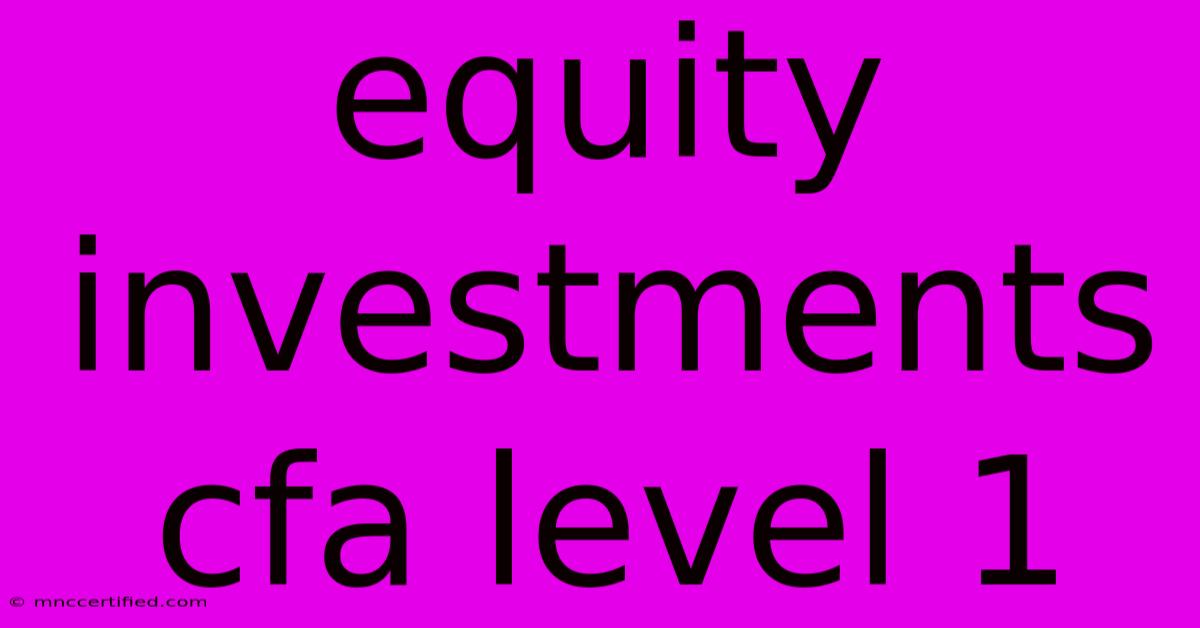Equity Investments Cfa Level 1

Table of Contents
Equity Investments: A Comprehensive Guide for CFA Level 1
The CFA Level 1 exam places significant emphasis on equity investments. Understanding equity valuation, market efficiency, and portfolio management strategies related to equities is crucial for success. This comprehensive guide breaks down the key concepts you need to master.
Understanding Equity Securities
Before diving into valuation and portfolio strategies, it's essential to grasp the fundamentals of equity securities.
Types of Equity Securities
- Common Stock: Represents ownership in a company, conferring voting rights and the right to receive dividends (if declared). Common stockholders are residual claimants, meaning they are paid after all other claimants (e.g., bondholders) in the event of liquidation. Understanding the different classes of common stock (with varying voting rights) is key.
- Preferred Stock: A hybrid security with characteristics of both debt and equity. Preferred stockholders typically receive a fixed dividend payment before common stockholders, but generally have limited or no voting rights. Understanding the features of preferred stock, such as cumulative vs. non-cumulative dividends and participating vs. non-participating features, is vital.
- American Depositary Receipts (ADRs): Represent ownership in foreign companies, traded on U.S. exchanges. These provide a convenient way for U.S. investors to access foreign equity markets. Understanding the different types of ADRs is important.
- Global Depository Receipts (GDRs): Similar to ADRs, but traded on exchanges outside the issuer's home country. Understanding the differences between ADRs and GDRs is crucial for the CFA exam.
Equity Market Indices
Understanding how equity market indices are constructed and their implications is critical. The CFA curriculum covers various index methodologies, including:
- Market-capitalization-weighted indices: Weights are proportional to market capitalization.
- Price-weighted indices: Weights are proportional to the price of the constituent stocks.
- Equal-weighted indices: All stocks have equal weight.
You need to know the advantages and disadvantages of each methodology and their impact on portfolio performance measurement. Familiarize yourself with major indices like the S&P 500, Dow Jones Industrial Average, and FTSE 100.
Equity Valuation
This section forms a significant portion of the CFA Level 1 curriculum. You'll need a strong grasp of various valuation models:
Discounted Cash Flow (DCF) Models
- Dividend Discount Model (DDM): Values a stock based on the present value of its future dividends. Understand the Gordon Growth Model (constant growth DDM) and its limitations. Be prepared to apply the model under different growth scenarios.
- Free Cash Flow to the Firm (FCFF) Model: Values the entire firm based on its free cash flows. Understand how to project free cash flows and discount them to present value.
- Free Cash Flow to Equity (FCFE) Model: Values the equity portion of the firm based on its free cash flows available to equity holders. This model is particularly useful when a company has significant debt.
Relative Valuation Models
These models value a stock based on its multiples relative to comparable companies or industry averages.
- Price-to-Earnings (P/E) Ratio: A widely used metric comparing a company's stock price to its earnings per share. Understand the variations in P/E ratios based on growth prospects and risk.
- Price-to-Book (P/B) Ratio: Compares a company's market capitalization to its book value of equity. Useful for valuing companies with significant tangible assets.
- Price-to-Sales (P/S) Ratio: Compares a company's market capitalization to its revenue. Useful for valuing companies with little or no earnings.
Market Efficiency and Behavioral Finance
Understanding market efficiency and its implications is essential. The CFA curriculum covers the three forms of market efficiency:
- Weak Form: Prices reflect all past market data. Technical analysis is ineffective.
- Semi-Strong Form: Prices reflect all publicly available information. Fundamental analysis may offer an edge.
- Strong Form: Prices reflect all information, public and private. No method can consistently outperform the market.
Behavioral finance explores how psychological biases can influence investor decisions and lead to market inefficiencies. Familiarize yourself with common biases like overconfidence, herding, and anchoring.
Portfolio Management and Equity Strategies
The CFA Level 1 exam tests your understanding of portfolio construction and various equity investment strategies:
- Passive Investing: Strategies that aim to match the market return, often using index funds or ETFs.
- Active Investing: Strategies that aim to outperform the market by identifying undervalued securities or market timing. This includes various approaches like value investing, growth investing, and fundamental analysis.
- Factor Investing: Investing based on factors that are believed to explain asset returns, such as value, size, momentum, and quality.
- Sector Rotation: Adjusting portfolio allocation based on anticipated sector performance.
Conclusion
Mastering equity investments is vital for success in the CFA Level 1 exam. Thorough understanding of the concepts outlined above, combined with consistent practice, will significantly improve your chances of passing. Remember to utilize practice questions and official CFA curriculum materials to solidify your knowledge. Good luck!

Thank you for visiting our website wich cover about Equity Investments Cfa Level 1. We hope the information provided has been useful to you. Feel free to contact us if you have any questions or need further assistance. See you next time and dont miss to bookmark.
Featured Posts
-
Portsmouth Vs Millwall Game Postponed
Nov 28, 2024
-
Lana Del Rey 2025 Tour Ticket Prices And Dates
Nov 28, 2024
-
Celtic Park Volcano Bees Swarm
Nov 28, 2024
-
How To Invest In Natron Energy
Nov 28, 2024
-
Millwall Portsmouth Match Power Cut Stoppage
Nov 28, 2024